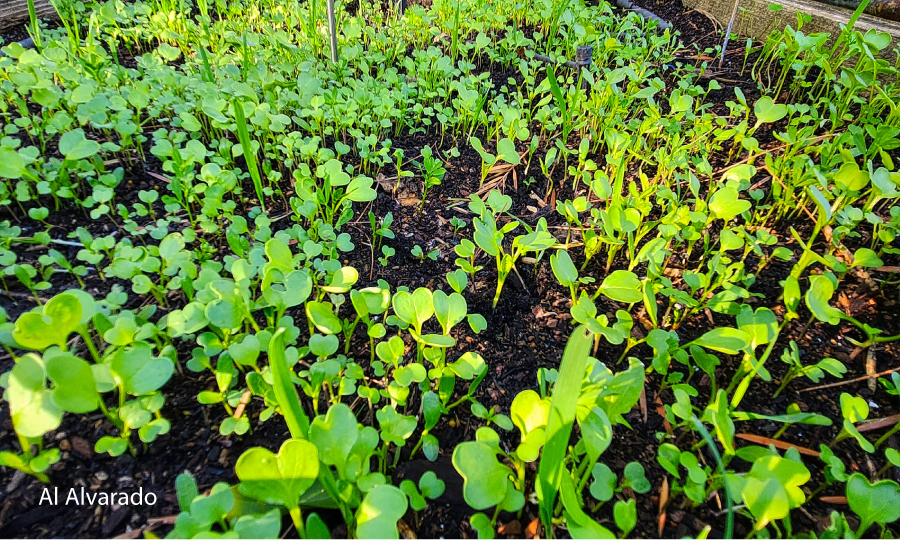Edible Garden Rest and Rejuvenation: Cover Crops

By Valorie Shatynski
Fall and winter months in San Diego County are mild, which offers the opportunity for nearly year round growing in the edible garden. However, September and October are the ideal months to plant a cover crop for edible garden restoration. If the soil in your garden has been productive for several years without rest, a good method for restoration is to plant and grow a cover crop until spring planting. Cover crops will boost soil fertility, and many are used to fix nitrogen and suppress soil nematodes and related fungi. It should be noted that not all nematodes (microscopic worms) are detrimental. Use of cover crops rather than chemicals is a far safer way to keep the balance of nature.
Prepare the planting bed by clearing all edible garden growth and add it to a compost pile or bin. Seed the area to the depth following the instructions provided with each specific seed type to be used as the cover crop. Ideally, cover crop seeding should be planted broadly over the area rather than in rows, to provide total cover of the soil as the plants mature. This will help suppress weeds, protect the soil from wind and erosion, and increase water retention. Water the area as recommended for seed growth, and as needed to sustain the crop through springtime.
Determining what to use as a cover crop is important. Nitrogen fixing is often a goal of cover cropping, as it is a component of chlorophyll and amino acids, critical to plant leaf and stem growth. The most common evidence that nitrogen has been depleted is stunted growth and yellowing leaves of the edible crop. Plants from the legume family that are the most efficient for nitrogen fixing are vetch, alfalfa, sweet clover, and true clover. Others are peanuts, cowpeas, fava beans and soybeans. Common beans do not have the same efficiency as those listed here.
Suppression of most common harmful vegetable garden nematodes (called root-knot nematode) can be achieved by raising mustard plants as the cover crop. The most obvious symptom of the root-knot nematode is swollen sections on the plant roots, referred to as knots or galls. The root-knot nematode feeds on the root tissue, absorbing carbohydrates, and interrupting water flow. Plants affected often appear starved for water. Nematodes breed in the roots and soil. Mustard and African and French marigolds are NOT root-knot nematode hosts, therefore the beds planted with these prevent the nematodes from thriving. Radishes can be used in early spring, but be sure to destroy or harvest the radishes within 30-35 days after planting. This will prevent the egg production cycle of the nematode. If left longer, the eggs may hatch making the use of radishes ineffective.
Cover crops are harvested at least 3 weeks and up to 6 weeks before spring edible planting. When 25% to 50% of the crop is flowering (around February or March), cut the crop down and chop up the greens. Do not allow the cover crop to go to seed! Mix the chopped cover crop greens into the planting bed to 6”-8” depth. Check before planting spring edibles to ensure the greens have been completely broken down. This process provides added nutrients to the soil as decomposers such as worms and beneficial insects do their work. The added benefit is that the soil will be naturally tilled by these organisms.
An internet search for the phrase “cover crop seeds” will provide seed sources. Determine the size of the area for the cover crop, and purchase the quantity according to the guidelines for the type of seed.
When the bed is ready for spring planting, consideration of edible crop rotation is also critical. Crop rotation information can be found here: https://www.mastergardenersd.org/planning-a-vegetable-garden-layout-crop-rotation/
The following chart provided by the UC Marin Master Gardeners provides a few other uses of cover crops in gardens and landscapes.
WHAT TO PLANT - Choose a cover crop based on your goals:
| Improve soil structure | Plant deeply rooted plants and/or plants with large biomass such as barley, rye, and daikon radish. |
| Build soil microbial biomass | (fungi, bacteria, and other microbes): Plant Phacelia. |
| Protect the soil from erosion | Plant grasses, mustard, and radish. |
| Suppress weeds | Plant grasses, mustard, and radish. |
| Attract beneficial insects | Plant mustard and radish. (These plants may also attract undesirable insects such as cucumber beetles and stink bugs). |
Lastly, cover crops can provide aesthetic beauty to the garden over winter, while being of beneficial use to many organisms found in the soil and landscapes.
References:
Nematodes in Home Gardens and Landscapes, Michigan State University, Plant & Pest Diagnostics
https://www.canr.msu.edu/resources/nematodes-in-home-gardens-and-landscapes
What to Do Off Season in the Edible Garden, UC Marin Master Gardeners:
https://marinmg.ucanr.edu/EDIBLES/COVERCROPSETC/
Valorie Shatynski, UCCE Master Gardener

